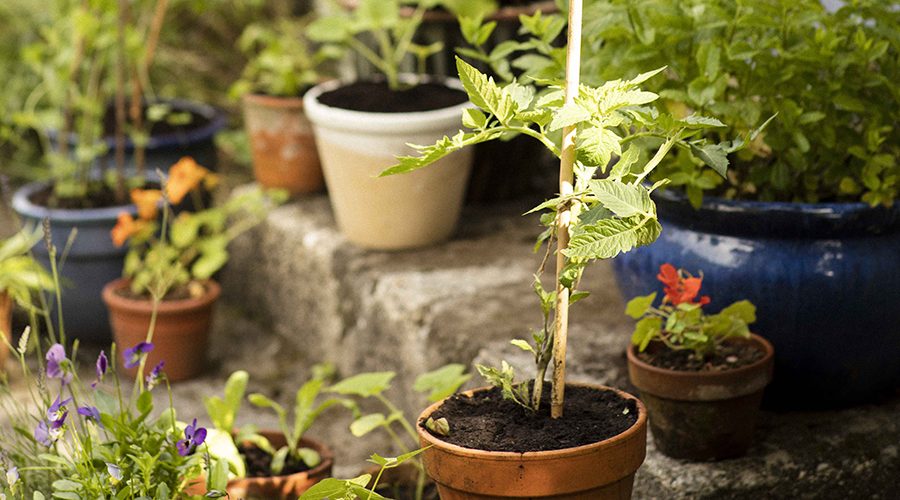If you’re planning to grow your own this season but you’re short on space, then you’ll find some useful tips below.
Choosing what to grow:
- Salad leaves are a brilliant crop for small spaces. They needn’t take up much space at all if you treat them as cut & come again. Plant them close together and keep harvesting the outer leaves. You could plant 15-20 different salad plants in a single grow bag and have a huge crop. Or 3-4 plants in a reasonably large, but fairly shallow pot.
- Choose the veggies that give you maximum yield. Fruiting veg like tomatoes, peas and beans will give you plenty to harvest over several weeks. Leafy crops like spinach and chard will keep going for months. Choosing your veg plants like this can keep you harvesting for longer so you’ll get more from your small plot.
- If you don’t have much sunlight, try these plants: Salad leaves, spinach, chard, coriander, parsley. They will all produce plenty of leaves for you to enjoy even when grown in partial shade.
- Veggies that can be planted closer together – steer clear of space-hungry plants and choose instead plants that have smaller spacing requirements: beetroot, carrots, baby sweetcorn, dwarf beans, salads, lettuces, spring onions,
Different types of containers to consider:
- A small crate planter is perfect on a balcony or patio. For maximum cropping, set the planter so that it faces the sun with the long edge at the back. Along the back, use 2 short bamboo canes and some chicken wire to make a little trellis, about 50cm high. Grow 10 sugar snaps or pea plants along this trellis. Then, in front of the peas, you will have space to grow a few rows of veg, running from back to front. Dwarf french beans, salad leaves and lettuces would work well.
- Window boxes are great for: cut & come again lettuces, rocket and mizuna, as well as herbs. Spring onions grow quite quickly and take up little space.
- Grow Bags: Strawberries usually grow really well and you could easily grow 6-8 to a grow bag. Dwarf Beans, Bush Tomatoes, and Chillies/Peppers work well too. If you can set a trellis behind the grow bag, you could plant 3-5 climbing bean plants to a grow bag, or a couple of trailing squash plants.
- A medley of pots: The key to choosing pots is making sure there is enough root space for the plants. If you have, say, 10-20 pots that are 20cm+ in diameter/depth, then you’ll be able to grow a reasonable amount.
Top Tips for Specific Veg:
- Pumpkins & Winter Squash – The trailing varieties of our squash and pumpkin varieties will naturally climb, making them perfect for growing vertically up against a trellis or sturdy fence. Just make sure they have a deep container each, or one or two to a grow bag.
- Cucumbers – Provide a support for cucumbers to climb and they’ll only need a 15 litre pot (20cm ish) per plant.
- Climbing Beans, Mangetout & Peas – Again, a trellis against a wall or fence is great for climbing beans and peas. If you have a deep windowbox (25-30cm deep) you can line them along the base of the trellis and pop the plants in there to grow. This takes up hardly any space at all compared to building a wigwam or a-frame support.
- Courgettes – Most of our varieties are bush varieties and will do well individually planted in large, deep 40-50cm pots.
- Grow potatoes in an old wheelbarrow or tyre stack. If you have a patio garden, this is a good way to grow potatoes and needn’t take up much space. 4-5 seed potatoes to a tyre stack/wheelbarrow will produce a good crop.
- Root Veg, Leeks & Onions – If you can find a wide and deep planter, or if you just have a single raised bed, then you could try carrots, parsnips, celeriac and swede. 25cm deep is probably the minimum for parsnips, but you could probably grow carrots in something 15cm deep. Beetroot will be fine in a more shallow container as their roots do not go so deep. (Our Crate Planters are a good place to start – they’re 15cm deep, so good for carrots, parsnip & turnips)
- Kale, Broccoli, Cabbages & Cauliflower – these plants need a bit more space, so if you’re limited we’d suggest sacrificing them for other things. However, you CAN plant a single plant to a large & deep 40cm pot. Curly Kale is a good compromise if you’re keen to grow kale as it’s more compact than the other varieties.
- Spinach & Chard – these are quite flexible, so you can either plant individually in 5 litre pots, or group them together into a planter leaving 20cm between plants and harvest regularly to keep the plants small.
- Tomatoes, Aubergines, Peppers – if growing in individual pots, choose a 15 litre pot minimum (bigger would be better) and give a regular liquid feed to keep the plants nourished.

